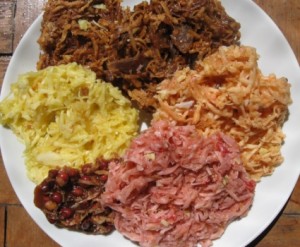
Photo © Michael Sommers.
A friend of mine spent a weekend on the “Ilha” (i.e the Ilha de Itaparica– the long, narrow island only a ferry-boat away from Salvador across the Bay of All Saints) and brought me back a very sweet gift: cocada. Actually he brought me 6 of them (pictured above). Although I’m a great fan of this Bahian sweet, which in its most basic form consists of freshly grated coconut and sugar, one is usually quite sufficient to give me a week’s sugar fix.This particular friend, however, is nothing if not extravagant and so aside from a basic snowy white cocada branca, I received one with amendoins (peanuts), maracujá (passion fruit), abacaxi (pineapple), mamão (mango), and jenipapo (a tart native fruit of the Northeast that has no translation).
The addition of fruit in cocada is quite common these days, but traditional cocadas came into two colors: branca (white) and preta (black), the latter obtaining its mahogany hue from the use of caramelized sugar. Back in colonial times, when Bahia’s sugar trade was booming, there was sugar in excess. But while the white aristocrats and plantation owners imported their sweets from Europe – or reproduced traditional Portuguese convent desserts laden with egg yolks and almonds – African slaves made use of the materials at hand – sugar, water, coconut – to satisfy their sweet cravings.
Before – and particularly after – the abolition of slavery, poor black Bahian women, dressed in traditional white turbans and long hoop skirts, took to the streets of Salvador with their tabuleiros to hawk home-cooked delicacies. Although today, the most famous of these Bahian treats is the spicy and savory bean fritter, acarajé, baianas also sell cocada as well as bolinhos de estudante.
Cocadas are inevitably on the dessert menus of the finest Bahian restaurants in town. Like cocada, the origin of bolinhos de estudante dates back to colonial times and, once again, underscores the improvisational talents of Bahia’s slaves. While their masters waited weeks and months for precious wheat flour to arrive from overseas, Afro-Brazilian women took a page from the local Tupi Indians and used tapioca flour, mixed with coconut milk and grated coconut, to make dough balls that were then rubbed in sugar, deep fried, and sprinkled with cinnamon.Despite the fact that both treats have humble origins, their cross-over appeal has been universal. Cocadas are inevitably on the dessert menus of the finest Bahian restaurants in town (often as cocada mole, whose creamier “soft” (i.e. mole) consistency is achieved by the addition of butter and/or egg yolks (fragrant cinnamon and cloves are also added). The dessert’s universal popularity is reflected by its entering the vernacular: a common local expression for someone whose head has gotten way too big for their britches is to refer to him/her as “rei (king)/rainha (queen) da cocada preta.”
As for bolinhos de estudante – originally known as bolinhos de negra after the black women who made them – they owe their current name (“student balls”) to the fact that these inexpensive snacks have students of all ages (and often little means) lining up at baianas’ stalls that are strategically placed in front of schools and universities. A more popular slang term for a bolinhos de estudante is a punheta (bater punheta is the Brazilian equivalent of “spanking the monkey”), which alludes both to their phallic form as well as the friction motion required by the two hands that kneed the tapioca dough.
Friends of mine recall that back in the day, you could find cocada and bolinhos de estudante on every street corner. Although the ranks of women selling these sweets have definitely dwindled, you’ll find some very good options at Cira’s stalls at Largo do Itapuã and Rio Vermelho’s Largo da Mariquita; at the stall of the baiana currently parked in front of the Casa de Jorge Amado in the Largo do Pelourinho; and of course, while waiting for the ferry from Itaparica to Salvador.
Those of you who won’t be in Salvador anytime soon might want to compensate by listening to this delicious samba, Cocada Boa (from his 1993 album of the same name) performed by Recife-born sambista Bezerra da Silva.